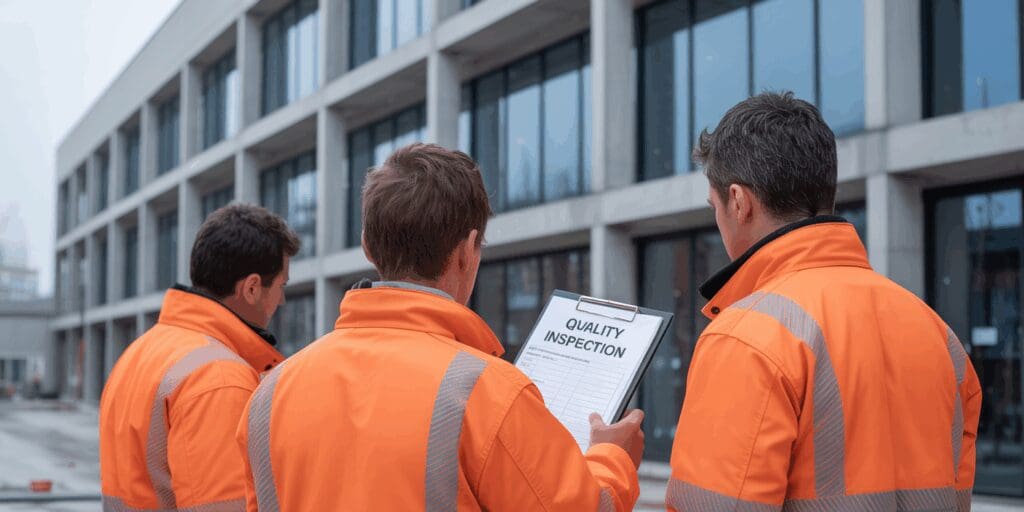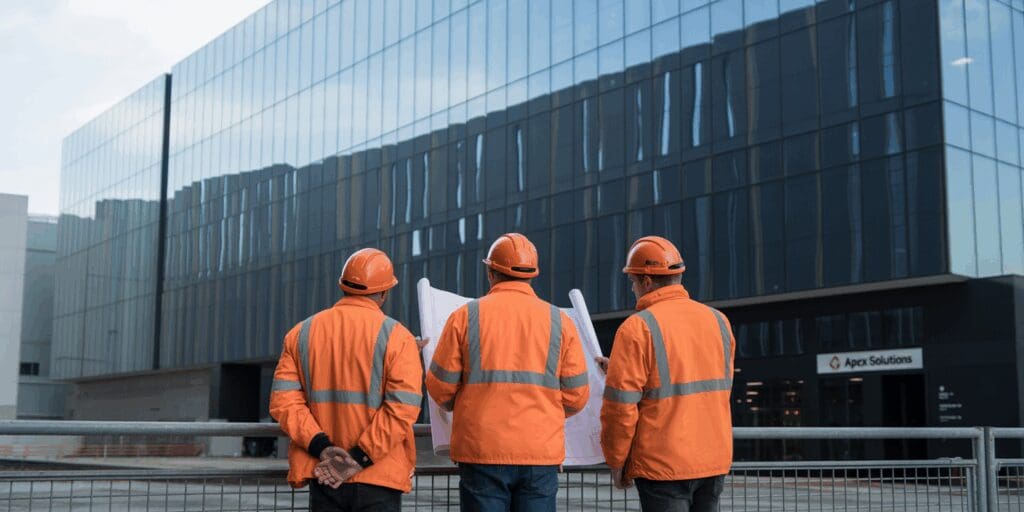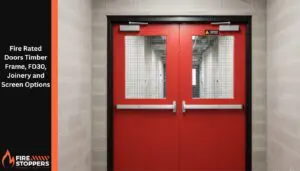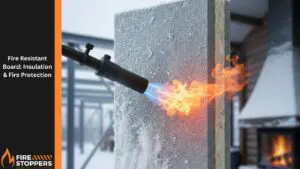Effective fire safety management is an absolutely essential pillar of any successful construction project in Ireland. This isn’t merely a box-ticking exercise; it is the proactive and legally mandated process of protecting lives, safeguarding property, and securing your investment. This article will act as your comprehensive guide to understanding and implementing robust fire safety protocols tailored to the Irish market, which you can read more about on our blog. We will explore the critical aspects of fire safety management, from your legal duties under Irish law and the necessity of getting a Fire Safety Certificate, to the on-the-ground practicalities of fire prevention and emergency readiness on a busy site. For any project manager, building owner, or professional in the Irish construction sector, this article provides the essential guidance to manage fire risks, ensure compliance, and foster a safe environment for all.
Table of Contents
- What is Fire Safety Management and Why is it Crucial for Your Building Project?
- What Are Your Legal Obligations Regarding Irish Fire Safety Legislation?
- How Do You Conduct a Thorough Fire Risk Assessment?
- What are the Core Components of an Effective Fire Safety Management Plan?
- How Can Expert Fire Safety Consultancy Services Enhance Your Project?
- What is the Role of Design and Engineering in Fire Prevention?
- How Do You Effectively Manage Fire Safety on Active Construction Sites?
- What are the Essential Elements of Emergency Plans and Evacuation Procedures?
- How Do You Ensure Ongoing Maintenance and Updates to Your Fire Safety Systems?
- What Are the Benefits of Proactive Management of Fire Safety?
What is Fire Safety Management and Why is it Crucial for Your Building Project?
So, why is fire safety important? Fire safety management is a structured, ongoing process designed to prevent the outbreak of a fire, and to control and mitigate the consequences should a fire occur. It covers the entire lifecycle of a building, from the very first design concepts and construction work to its final occupation and routine maintenance. The core objective is to ensure the safety of every individual in and around the building, while also protecting the physical structure and its contents. Achieving this requires a holistic approach that includes identifying potential fire hazards, performing detailed risk assessments, and putting in place suitable control measures. Under Irish law, this is a fundamental legal and moral responsibility for the person in control of a premises.
The critical importance of diligent fire safety management within a building project cannot be overstated. A major fire event can lead to tragic outcomes, including fatalities, severe injuries, and devastating financial losses. For any construction project, a fire can cause massive delays, ballooning costs, and inflict severe damage on a company’s reputation. Proper safety management works to avert these disasters by fostering a safe working environment and making sure all personnel on site understand their roles in preventing and responding to a fire. Proactive management of fire safety is a hallmark of a professional and well-run operation, demonstrating a clear commitment to the welfare of workers and the public.
Furthermore, a comprehensive fire safety management system is not just about having an emergency plan; it’s about embedding a culture of fire prevention into the project’s DNA. This involves thorough training for the workforce, enforcing safe work practices, and consistently reviewing and updating safety procedures. By weaving fire safety into every phase of the project, from initial drawings to handover, the likelihood of a fire is drastically reduced. This proactive approach is vital to safeguard your investment and, most importantly, the lives of those who build and will ultimately use the building.

What Are Your Legal Obligations Regarding Irish Fire Safety Legislation?
Navigating the specific legal framework for fire safety in Ireland is a cornerstone of responsible project management. The primary legislation includes the Fire Services Acts 1981 & 2003 and the Safety, Health and Welfare at Work Act 2005. These acts place a legal duty on the “person having control of premises” – which can be the owner or occupier – to take all reasonable measures to guard against the outbreak of a fire and to ensure the safety of everyone on the premises. A key part of this regulation is the legal requirement to carry out a suitable and sufficient fire risk assessment and to implement all necessary fire safety measures.
Detailed technical requirements are laid out in the Building Control Regulations 1997 to 2024 and the associated Technical Guidance Documents, particularly Technical Guidance Document B (Fire Safety). These documents specify the standards for materials, the design of escape routes, and the mandatory installation of systems for fire detection, alarms, and emergency lighting. It’s crucial to understand that this safety legislation evolves. Therefore, all parties involved in a construction project must ensure the design and build fully comply with the current regulations. Non-compliance can lead to prosecution, significant fines, and invalidate insurance.
The responsibility for achieving passive fire protection compliance is shared among the client, designers, builders, and specialist consultants. Appointing a competent person with the right training, experience, and knowledge to oversee fire safety is a key requirement. A critical piece of documentation is the fire register, which logs all fire safety activities, including risk assessments, staff training, and the maintenance of equipment. This register is not just a legal formality but a vital tool for the effective management of fire safety.
How Do You Conduct a Thorough Fire Risk Assessment?
A fire risk assessment, often part of a wider fire safety survey, is the very foundation of an effective fire safety management plan in any Irish workplace. It is a methodical process of identifying any potential fire hazards and evaluating the associated risk to people and property. The goal of the assessment is to determine precisely what measures are needed to prevent a fire and to keep people safe. This assessment must be carried out by a competent person who possesses the necessary skills, knowledge, and experience in fire safety. The process involves identifying hazards, assessing the risks they present, and implementing control measures.
The first step is a thorough search to identify all potential fire hazards. This means looking for sources of ignition (e.g., heaters, or even water in an electrical outlet), sources of fuel (e.g., wood, paper, flammable liquids, waste materials), and sources of oxygen. On a construction site, this list is extensive and ever-changing. The next step is to identify everyone who could be at risk, including workers, contractors, visitors, and the public, paying special attention to anyone who may need help to evacuate safely.
Once you have identified the hazards and the people at risk, the crucial next step is to evaluate the level of risk. This involves considering the likelihood of a fire starting and the potential severity of the consequences. This evaluation allows you to prioritise the necessary control measures to reduce the fire risks to an acceptable level. These measures include both fire prevention actions and protective measures (like installing a fire alarm and ensuring clear escape routes). The significant findings of your assessment, the measures you have taken, and your emergency plan must be recorded in writing. This record, often part of your fire register, is a legal requirement and demonstrates due diligence. The assessment is a living document and must be reviewed regularly.

What are the Core Components of an Effective Fire Safety Management Plan?
An effective fire safety management plan is the formal, written document that details the specific arrangements for managing every aspect of fire safety within a building. It is a legal necessity and a vital tool for ensuring a coordinated and effective response should a fire occur. The plan must be specifically tailored to the unique characteristics of the building and its use, and it must be regularly reviewed and updated. The core components of a robust fire safety management plan in Ireland will always include a detailed pre-fire planning guide, clear communication protocols, and strict procedures for the ongoing maintenance and testing of all fire safety equipment.
A critical part of the plan is the emergency procedure. This section must clearly detail the actions all occupants must take in the event of a fire. This includes how to raise the alarm, who to call (the local authority fire service), and the precise evacuation procedure. The plan must clearly define the escape routes, the location of assembly points, and the specific roles and responsibilities of key personnel, such as designated fire wardens. The plan must also address provisions for the safe evacuation of any vulnerable persons and special procedures for shutting down dangerous equipment or processes. Regular drills are essential to ensure every person is familiar with how to conduct a fire drill and can evacuate the building safely and quickly.
Beyond the emergency response, a comprehensive fire safety management plan must detail proactive fire prevention measures. This includes strict policies on hot work permits, designated smoking areas, and the safe storage and handling of flammable materials. The plan must also specify the arrangements for regular inspection, testing, and maintenance of all fire safety systems, such as the fire alarm system, emergency lighting, fire extinguishers, and any sprinkler systems. All these activities must be meticulously recorded in the fire register to ensure a verifiable record of compliance and due diligence.
How Can Expert Fire Safety Consultancy Services Enhance Your Project?
Engaging professional consultancy services can provide indispensable expertise and support for a construction project in Ireland. A reputable consultancy will employ experienced fire engineers and consultants who can offer expert guidance on all facets of fire safety. Their services are valuable from the earliest design stage, through construction, and into the ongoing management of the occupied building. Their deep knowledge of Irish safety legislation, the Building Control Regulations, and Irish Standards (I.S.) is crucial for ensuring your project not only achieves full legal compliance but also embodies the highest standards of fire safety.
A primary advantage of using a fire safety consultancy is their role in navigating the Fire Safety Certificate (FSC) process. For most new non-domestic buildings, material alterations, or changes of use, an FSC from the local Building Control Authority is mandatory before work commences. A consultant can prepare the detailed application, including technical drawings and a comprehensive report demonstrating how the design complies with Part B of the Building Regulations. This expert preparation is vital for a smooth approval process and to avoid costly delays. Their independent assessment of your plans can identify potential issues early on, proposing effective solutions.
Furthermore, a fire safety consultancy is invaluable in developing and implementing your overall fire safety management system. They can assist in drafting a site-specific fire safety plan, creating effective emergency procedures, and delivering competent training for your staff and fire wardens. Their involvement helps embed a strong culture of fire safety within the project, giving the client and management team confidence that they are fulfilling their legal duties to protect people and property from the catastrophic risk of fire.
What is the Role of Design and Engineering in Fire Prevention?
The design and engineering phase of a building project is fundamentally important for establishing a robust foundation for fire safety. Early engagement with fire safety experts is critical. Decisions made by the architect and engineer at this stage have a lasting impact on the building’s inherent ability to resist the start and spread of fire and smoke, and to facilitate the safe evacuation of every occupant. A competent designer and engineer collaborate to create a building that is not only functional and aesthetically pleasing but is also intrinsically safe from a fire perspective. This involves careful consideration of the building’s layout, the specification of materials based on their reaction to fire, and the seamless integration of both passive and active fire protection systems, all guided by Technical Guidance Document B.
Passive fire protection measures are integrated into the very fabric of the building to form a physical barrier against the spread of fire and smoke. This includes the use of fire-resistant walls, floors, ceilings, and fire doors to achieve effective fire compartmentation. These compartments are designed to contain a fire to its area of origin for a specified period, allowing occupants time to escape. The design of the escape routes is a critical passive measure, ensuring there are sufficient, clearly marked, and protected exits. The designer must meticulously calculate travel distances and ensure the escape route is of adequate width for the number of people who might use it in an emergency.
The difference between active and passive fire protection is crucial; the systems must work together. Active systems require action or motion to work in the event of a fire. This primarily includes fire detection and alarm systems, which provide an early warning, and fire suppression systems like sprinklers, which can automatically discharge water to control or extinguish a fire. The engineer is responsible for designing these systems to meet the specific requirements of the building and to comply with Irish standards such as I.S. 3218 for fire alarm systems. Obtaining a Fire Safety Certificate before construction begins is a legal requirement that validates the adequacy of the proposed active and passive design measures with the local authority fire service.

How Do You Effectively Manage Fire Safety on Active Construction Sites?
Managing fire safety on active construction sites in Ireland poses significant challenges due to the dynamic environment and the constant presence of ignition sources and combustible materials. Effective safety management on construction projects demands a vigilant and proactive approach, heavily focused on fire prevention and preparedness, all underpinned by the Safety, Health and Welfare at Work (Construction) Regulations. The site manager has a clear legal duty to ensure the safety of everyone on site by taking all necessary precautions to prevent a fire. This involves implementing a comprehensive fire safety plan that is specific to the site and is continuously reviewed and updated as the project evolves.
A primary concern on construction sites is the strict control of ignition sources and flammable materials. Hot work, such as welding, grinding, or using tar boilers, is a major hazard and must be strictly controlled through a formal hot work permit system. All flammable liquids, gases, and other combustible substances must be properly stored in designated, secure, and well-ventilated areas, far from potential ignition sources. It is also vital to enforce good housekeeping, avoiding common firestopping mistakes and ensuring that waste materials are removed regularly to prevent the accumulation of fuel for a potential fire. All temporary electrical installation work must be carried out by a qualified electrician and be subject to regular inspection.
In addition to fire prevention, having adequate fire-fighting equipment readily available is essential. This includes locating the correct type of portable fire extinguishers at designated ‘Fire Points’ at each level and near specific hazards, and knowing when to replace a fire extinguisher. All site personnel must be trained in their use and know how to raise the alarm. There should be a clear evacuation plan for the site, with well-signed escape routes and a designated assembly point. Regular fire drills are not optional; they are crucial for testing the plan’s effectiveness and ensuring a swift response. This proactive management of fire is a non-negotiable element of modern project management.
What are the Essential Elements of Emergency Plans and Evacuation Procedures?
A well-documented and clearly communicated emergency plan with a supporting workplace fire evacuation procedure is an essential component of any fire safety management system. The primary purpose of these plans is to ensure that, in the event of a fire, everyone in the building can evacuate to a place of safety quickly and efficiently. The plan must be developed from the findings of the fire risk assessment and tailored to the specific characteristics of the building and its occupants. It is not enough to simply write a plan and file it away; it must be a living document that is regularly drilled, reviewed, and updated to remain effective.
The emergency plan must explicitly outline the actions every person must take when they discover a fire or when the fire alarm sounds. This includes the procedure for raising the alarm, methods for immediately notifying the fire and rescue service, and how to initiate the evacuation. The plan must identify the designated escape routes and ensure that they are kept clear of obstructions at all times. It’s also critical to have a reliable system for conducting a roll call at the assembly point to account for everyone and ensure no one has been left behind. The plan must also address the specific needs of any vulnerable individuals who may require assistance during an evacuation.
The evacuation procedure should be simple and easy for everyone to follow. It must be communicated effectively through induction training, prominent notices, and, most importantly, regular fire drills. The procedure needs to clearly state the location of the muster or assembly point, which must be a safe distance away from the danger of the fire. It should also define the roles and responsibilities of key personnel, such as fire wardens, who are trained to manage the evacuation and liaise with the emergency services upon their arrival. By having clear and well-practiced emergency plans and procedures in place, you dramatically increase the chances of a safe outcome in the event of a real fire.
How Do You Ensure Ongoing Maintenance and Updates to Your Fire Safety Systems?
The ongoing maintenance and regular updating of fire safety systems are absolutely critical to guarantee their reliability and effectiveness in the event of a fire. In Ireland, it is a statutory requirement to ensure that all fire safety equipment is kept in good working order. A proactive approach to preventative maintenance in firestopping not only ensures compliance with the law but also provides the essential reassurance that your building and its occupants are protected by a fully functional fire safety system. A formal maintenance scheme, which may include understanding fire upgrade works, must be established with a competent provider, and all activities must be diligently recorded in the fire register.
The maintenance program must be comprehensive, covering every element of the building’s fire safety systems. This includes the fire alarm system, emergency lighting, portable fire extinguishers, sprinkler systems, and any other fire-fighting equipment. Regular inspections and tests must be conducted according to the manufacturer’s instructions and, crucially, in line with the relevant Irish Standards. For example, you need to know how often fire alarms should be tested, and fire doors require regular checks as outlined in our fire door inspection checklist.
It is also important to regularly review and update your fire safety systems to ensure they remain adequate for the level of risk. This might be triggered by changes to the building’s layout or use, or to embrace newer, more effective fire safety technology. For instance, you might upgrade a conventional fire alarm to an addressable system that provides a more precise location of a fire, aiding a faster response. Any alterations to fire safety systems must be carefully planned and executed by a qualified engineer or technician. Through diligent maintenance and timely updates, you can be confident that you are providing the highest possible level of protection.
What Are the Benefits of Proactive Management of Fire Safety?
A proactive approach to the management of fire safety delivers profound benefits that go far beyond merely satisfying legal duties. By actively working to prevent fires before they can start, organisations create a genuinely safer environment for everyone, protect valuable assets, and significantly boost their operational resilience. This forward-thinking stance is the opposite of a reactive approach, which only addresses fire safety after an incident has already caused harm and loss. In any sector, from commercial offices to industrial sites like data centres, embracing proactive fire safety is a critical investment in long-term success and sustainability for any public and private enterprise.
One of the most significant benefits of proactive fire safety is the prevention of loss of life and injury. By systematically identifying and mitigating fire risks, you are fundamentally protecting the health and welfare of your employees, customers, and visitors. This demonstrable commitment to safety can also improve staff morale and foster a more positive and productive workplace. Furthermore, preventing a fire eliminates the enormous financial burdens associated with property damage, business interruption, legal fees, and rising insurance premiums. Indeed, good passive fire protection can lower insurance premiums.
Moreover, excellent fire safety management enhances an organisation’s reputation and builds trust with its client base, regulators, and the community. A strong safety record is a powerful indicator of corporate social responsibility and can be a significant advantage in a competitive marketplace. It signals that the management is competent, diligent, and genuinely cares for the well-being of its people. By investing in comprehensive fire safety strategies and expert consultancy services, a business demonstrates that it is a responsible and trustworthy partner. Ultimately, proactive fire safety is not just about avoiding tragedy; it’s about building a more secure, resilient, and successful future.
Summary of Key Takeaways
- Fire safety management is a legal requirement in Ireland under the Fire Services Acts and the Safety, Health and Welfare at Work Act.
- A Fire Safety Certificate (FSC) is mandatory for most new non-domestic buildings and significant alterations before work commences.
- A thorough fire risk assessment conducted by a competent person is the essential foundation of your safety plan.
- An effective management plan must include detailed emergency plans and procedures and proactive fire prevention measures.
- Expert fire safety consultancy services are invaluable for navigating Irish legislation and the FSC process.
- The initial design and engineering, guided by Technical Guidance Document B, are critical for inherent fire safety.
- Active construction sites require specific, robust fire safety plans to manage their unique and changing hazards.
- Clear, well-practiced evacuation plans are vital to ensure the safety of everyone in an emergency.
- Ongoing maintenance of all fire safety equipment to Irish Standards is a legal necessity.
- Proactive management of fire saves lives, protects property, ensures legal compliance, and enhances business reputation.



